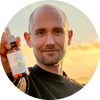The cost of a kg of pure NAD on average is around $200, but this isn't accessible to most people, and you'd typically have to keep it in a controlled environment to protect its potency and process the pure powder into pills or capsules before you can use it.
You may have come across exorbitant Nicotinamide Adenine Dinucleotide (NAD) IV therapy prices, ranging from $200 to $1000 per session. NAD supplements for sale are much more wallet-friendly, ranging from $30-$60 a bottle for a niche, healthy aging supplement, so you might be wondering, "Why is NAD IV so expensive?"
The short answer is that IV infusions typically take 2-4 hours to administer, so you're paying for both the time spent at the clinic and the specialized medical equipment and trained professionals.
Another reason why NAD IV therapy might be more costly is that most insurance policies don't cover it, as it's considered an elective or alternative medical treatment.

Reasons Why NAD Is Expensive
Nicotinamide Adenine Dinucleotide isn’t your average supplement.
Unlike basic vitamins and minerals, which are easily sourced and manufactured, NAD is a specialized coenzyme that plays a crucial role in cellular energy, DNA repair, and the healthy aging process.
Because it’s so complex, producing and delivering it effectively requires more than just mixing ingredients and putting them in a capsule.
So, let's get into the common reasons why NAD is pricer than your typical vitamin supplements.

NAD Production
NAD is a delicate molecule that's difficult to produce and even harder to stabilize for shelf life. Pure NAD+ degrades quickly when exposed to air, heat, or light. To keep its potency in supplements or IV bags, NAD must be manufactured in controlled lab conditions and packaged in low-moisture and light-blocking materials, and stored and shipped correctly.
Even if you're not using NAD directly, its precursors like nicotinamide mononucleotide (NMN) or nicotinamide riboside (NR) require precise, and often patented, manufacturing processes, which can drive up the cost of the final product.
The Demand is High and Growing
NAD, as a healthy aging compound, has become popular lately thanks to new research showing a correlation between our healthy NAD pools and a longer healthspan [1]. Biohackers, longevity researchers, and athletes have driven up demand for IV drip clinics, spas, and oral supplements.
Higher demand, especially for clean, lab-tested NAD products, means that manufacturers and businesses can charge more.
Extensive Research Behind Development
Although NAD seems to have popped up overnight, it isn't new to the scientific world. We've known for a while that the body naturally produces NAD, and it plays a crucial role in maintaining cellular and DNA health. It's been the subject of numerous studies for decades, focusing on aging, metabolism, and neurobiology.
This level of scientific interest often adds legitimacy, but also at a higher cost. The price can reflect years of research, funding for studies at elite institutions, and licensing technologies for NAD production and delivery methods.
Brands selling NAD-related products often invest in third-party testing, white papers, or proprietary research to validate their formulas, which adds to the final price tag.
Not All NAD Is Created Equal
You might find cheaper NAD products online, but quality matters. High-grade NAD and its precursors often undergo additional purification steps to remove impurities and ensure consistent dosing.
You’re paying for:
-
High-grade purity
-
Verified ingredient sourcing (no fillers or untested materials)
-
Certifications like GMP (Good Manufacturing Practice) or ISO standards
Liposomal & Injectable Forms Add to the Cost
Many NAD supplements use liposomal delivery systems to help improve bioavailability — how well your body absorbs the active ingredient. Creating high-quality liposomes requires advanced manufacturing equipment and specialized emulsifiers, which increases the overall cost.
Injectable or IV NAD+ — which bypasses the digestive system entirely — must be compounded under strict regulations, sometimes requiring a prescription and medical oversight, which also drives up the cost.
Is NAD Worth The Price Tag?
For people looking to optimize their health, yes, NAD is worth its cost.
NAD is expensive due to its manufacturing process, high demand, and the significant scientific effort invested in understanding its effects.
While most people don't find NAD IV therapy practical because of the time commitment for its infusions or cost, oral NAD dietary supplements seem to offer more flexibility in doses, convenience, and better value.
If you’re considering NAD⁺, it’s worth doing your homework. Look for:
-
Transparent sourcing
-
Third-party testing
-
Clearly labeled dosing
-
Reputable brands that follow FDA supplement labeling guidelines
NAD isn't the only way to support your body’s natural levels. Regular exercise, good sleep, intermittent fasting, and a diet rich in vitamin B3 (found in foods such as mushrooms, tuna, and peanuts) can also help maintain healthy NAD+ levels.
Resources:
-
Yaku, K., Okabe, K., & Nakagawa, T. (2018). NAD metabolism: Implications in aging and longevity. Ageing research reviews, 47, 1-17.




